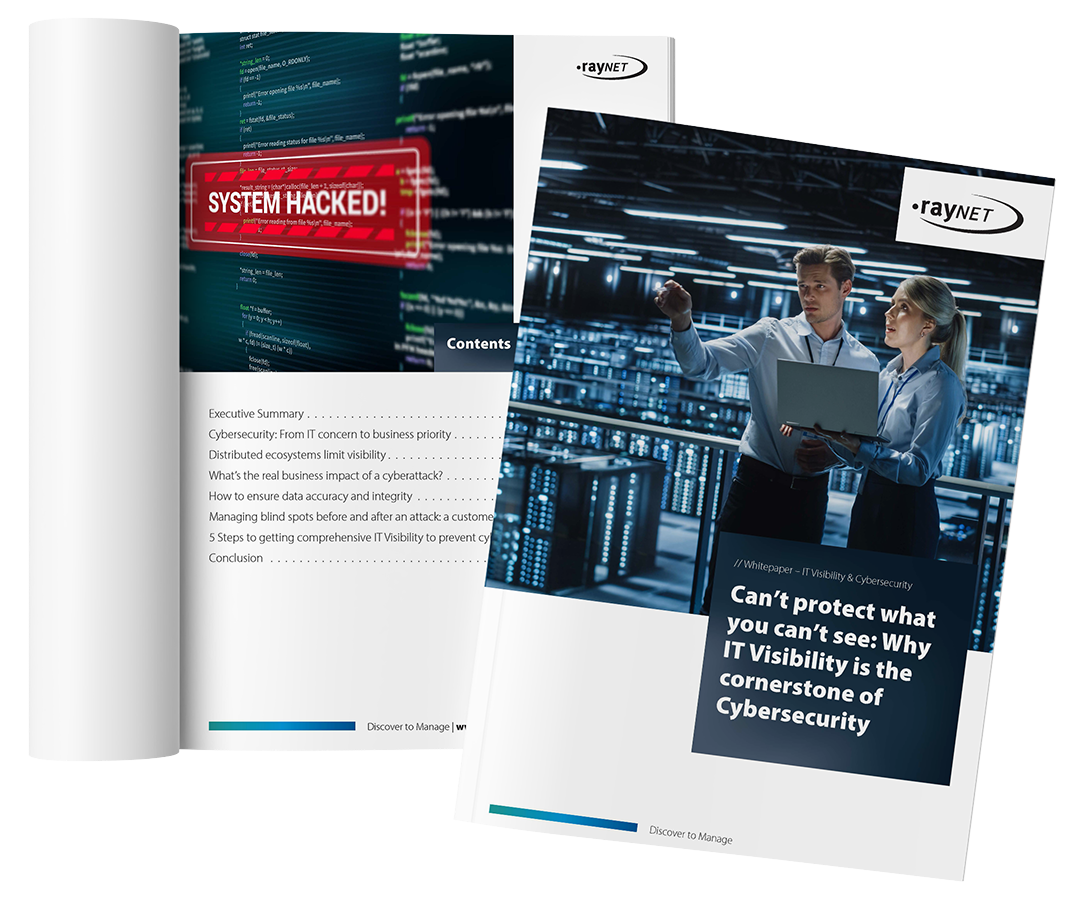Cybersecurity in healthcare: Here's why IT visibility is key to preventing cyberattacks
Reading time: 4 minutes
Date: August 8th, 2023
The number of cyberattacks on healthcare organizations and facilities has increased dramatically this year, and the threat level has never been more serious. Security experts and IT departments at clinics, hospitals or medical facilities are sounding the alarm and must ensure maximum IT security with limited resources.
But how does this happen in the first place? What is the reason for this onslaught on our healthcare system? In the grand scheme of things, it’s simple: hackers and cybercriminals want to cause as much damage as possible and make financial profit from their actions. Encrypting assets and data, or even stealing patient information, are means to an end and present healthcare organizations with a challenge that cannot be met alone.
Damage and consequences on an uncontrollable scale
Healthcare is just one part of what the German government has deemed to be critical infrastructures (KRITIS). According to the German Federal Office for Information Security (BSI), critical infrastructures “are organisations and facilities of major importance for society whose failure or impairment would cause a sustained shortage of supplies, significant disruptions to public order, safety and security or other dramatic consequences.“
This includes the following sectors:
State &
Administration
Information Technology
& Telecommunication
Transport &
Traffic
Municipal Waste Disposal
Finance &
Insurance
Media & Culture
Energy
Food
Water
Health
A security incident or breach in critical infrastructures (KRITIS) such as a healthcare facility is nothing trivial. The consequences and repercussions are serious and sometimes life-threatening. Disruption to ongoing hospital operations and day-to-day business are just some of the serious consequences of an attack. When a critical system needs to be shut down or disconnected, networks, communications, medical and electronic equipment could be rendered inaccessible and can severely limit medical care.
Minor surgeries are cancelled, critical treatments delayed, and vital operations are postponed or rescheduled. Emergency rooms have no access to patient records. Ambulances, emergency medical services or helicopters have to be redirected to other, potentially far-off hospitals and clinics – a disaster for patients, employees and the affected healthcare providers.
Author:
Related links:
Share blog:
Can't protect what you can't see: Why IT Visibility is the cornerstone of cybersecurity
In this whitepaper, we’ll show you how blind spots can weaken and even threaten your infrastructure. But we’ll also show you how IT Visibility can:
- Improve your security strategy
- Reveal hidden gaps and blind spots in your existing security measures
- Maintain business flexibilities
- Ensure your competitive edge
Regain control, protect data & guarantee security
When attacks happen, IT leaders and stakeholders must act quickly and prudently. Hospitals and clinics that have suffered an attack shut down their systems immediately and activate “disaster recovery” plans to minimize the damage, prevent data loss, and regain control as quickly as possible.
While crisis teams, IT departments, security officers and external IT service providers start analyzing the damage, ongoing operations remain restricted or even completely unavailable. Operations cannot be resumed until all systems, assets and networks are cleared according to security guidelines; in some cases, this recovery operations can take several days or weeks.
While data on the interruptions to healthcare due a cyberattack remains largely anecdotal, the consequences of an attack in 2021 were studied in detail. Scripps Hospital in San Diego, California suffered a ransomware attack that impacted operations for nearly four weeks. In that time, “adjacent hospitals witnessed a 15% increase in emergency department volume on a daily basis, and a 35% rise in ambulance arrivals each day. Waiting room times rose 47% (from 21 to 31 minutes) and the number of patients who left without being seen rose 128% (from 158 to 360)”, according to a study by UC San Diego.
Although it’s difficult to say what the long-term consequences for individual patients will have been, it’s clear that the quality of care suffered significantly in the days and weeks just following the attack.
more patients left the hospital without treatment
(360 patients daily)
Waiting time in the waiting room until admission & treatment
(Before: 21 minutes)
the cyberattack has cost the clinic, according to financial reports
($ 3.5 million to victims)
IT Visibility is the key to better security and more control.
A comprehensive overview of all hardware & software assets, networks, servers, as well as medical devices and devices in highly sensitive & specially protected areas is indispensable for controlling and securing IT infrastructure. Knowing what’s in your environment, whether endpoints are connected to security tools, what endpoint protection is applied, whether anti-virus software is installed, and what known vulnerabilities are in your infrastructure are crucial insights that can help you better protect your environment without purchasing additional security tools. The Raynet Unified Data Platform’s flexible inventory technologies provide organizations with complete inventories of even complex, decentralized, and hybrid IT environments within minutes.
Because the Unified Data Platform transforms and normalizes the data, giving it a standard form, the data can be used by a wide variety of IT management tools and different stakeholders & departments, so they don’t need to create their own siloed approach to data gathering and management in parallel. CSOs, CIOs, IT managers or security officers retain control over their infrastructure thanks to intelligent, intuitive & individualized dashboards, and are able to make strategically sound decisions – even in the event of a cyber-attack.
Acting instead of reacting: Prevention is the order of the day
There are certainly many technologies and solutions that can provide rapid assistance after a cyberattack and, to some extent, help to resume regular hospital operations. But hospital, clinic and medical facility managers are running a race against the clock.
Strategic security plans, IT security policy requirements and complex critical infrastructure regulations are the cornerstones of comprehensive IT security, but only by permanently monitoring potential threats and sensitizing employees to risks IT managers limit the impact of a cyber-attack, and help IT experts and authorities cooperate more effectively.
National and international information security guidelines and laws like the German KRITIS regulation shouldn’t be viewed as a burdensome and intrusive obligations; rather they should be implemented with even more rigor. Employee awareness, security training, and active employee cooperation are required to effectively identify threats, respond quickly, and leave no room for security incidents.
Discover how the Unified Data Platform combined with our many years of expertise can help your organization achieve greater security, more protection, and complete control.
Author:

SVP Technology & Information Managing Director
Related links:
Share this blog post:


